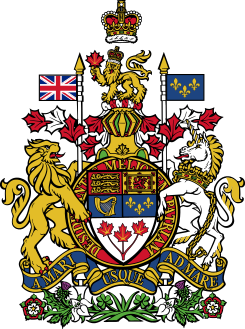Royal coat of arms of Canada
| Arms of Her Majesty the Queen in Right of Canada (Armoiries de Sa Majesté la Reine du chef du Canada) |
|
|---|---|
 |
|
| Details | |
| Armiger | Elizabeth II in Right of Canada |
| Adopted | 19 November 1921, revised 12 July 1994 |
| Crest | Upon a Royal helmet, a lion passant guardant or imperially crowned proper and holding in the dexter paw a maple leaf Gules. |
| Torse | Argent and gules, the mantling gules doubled argent. |
| Escutcheon | Tierced in fess, the first and second divisions containing the quarterly coat following, namely, 1st Gules three lions passant guardant in pale Or, 2nd, Or a lion rampant within a double tressure flory-counter-flory Gules, 3rd, Azure a harp Or stringed Argent, 4th, Azure three fleurs-de-lis Or, and the third division being Argent three maple leaves conjoined on one stem proper. |
| Supporters | Dexter a lion Or holding a lance Argent, point Or, flying therefrom to the Dexter the Royal Union Flag, Sinister a unicorn Argent armed, crined and unguled Or, gorged with a coronet composed of crosses-patée and fleurs-de-lis a chain affixed thereto and reflexed Or, holding a like lance flying therefrom to the sinister a banner Azure charged with three fleurs-de-lis Or. |
| Compartment | A wreath of roses, thistles, shamrocks and lilies proper. |
| Motto | A Mari usque ad Mare, Latin for "from sea to sea." |
| Orders | The ribbon of the Order of Canada inscribed Desiderantes Meliorem Patriam, Latin for "they desire a better country." |
| Other elements | The whole ensigned by the Royal Crown proper. |
| Earlier versions | Arms of Canada, revised 1957 |
The Arms of Canada (French: Armoiries du Canada), also known as the Royal Coat of Arms of Canada or formally as the Arms of Her Majesty The Queen in Right of Canada (French: Armoiries de Sa Majesté la Reine du chef du Canada), is, since 1921, the official coat of arms of the Canadian monarch and thus also of Canada. It is closely modelled after the royal coat of arms of the United Kingdom with French and distinctive Canadian elements replacing or added to those derived from the British version.
The maple leaves in the shield, blazoned "proper", were originally drawn vert (green) but were redrawn gules (red) in 1957 and a circlet of the Order of Canada was added to the arms for limited use in 1987. The shield design forms the monarch's royal standard and is also found on the Canadian Red Ensign. The Flag of the Governor General of Canada, which formerly used the shield over the Union Flag, now uses the crest of the arms on a blue field.
The arms are embossed on the cover of any citizen's Canadian passport, in order to legally signify and symbolize that the bearer is travelling under the aid of the Crown of Canada.
Prior to Confederation in 1867, the Royal Arms of the United Kingdom served in Canada as the symbol of royal authority. Arms had not been granted to any of the colonies in British North America, apart from 17th-century grants to Nova Scotia and Newfoundland. The year after Confederation, arms were granted by Royal Warrant on May 26, 1868 to Ontario,Quebec,Nova Scotia (that Nova Scotia had been granted arms was forgotten, and it took until 1929 for the historic arms granted in the 17th century to be reinstated) and New Brunswick. In the Royal Warrant of 1868, Queen Victoria authorized the four arms of the first provinces to be quartered for use on the Great Seal of Canada and while this was not done for the first Great Seal, it is through this reference it became the de facto arms for Canada until 1921. That is why it was in this form Canada was represented on the first Red Ensign carried by Canadian troops at Vimy Ridge in 1917.
...
Wikipedia
